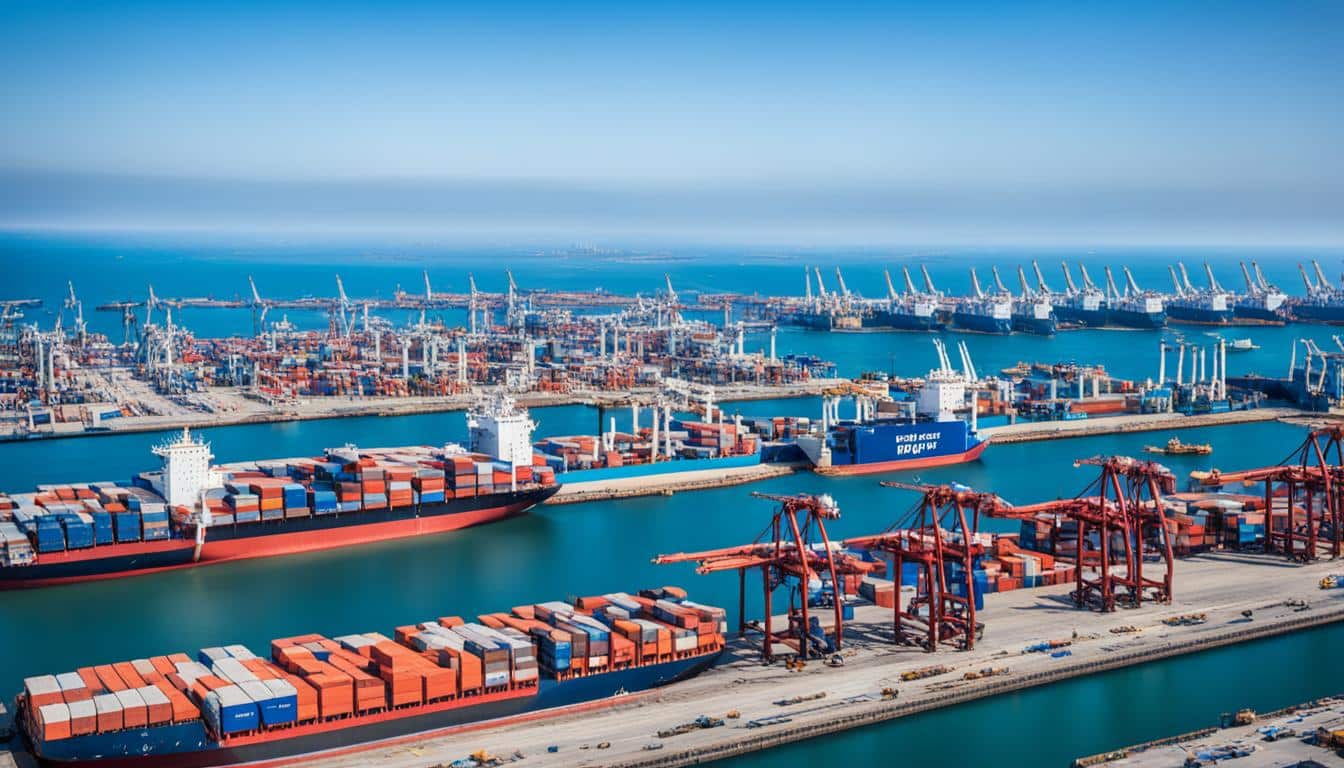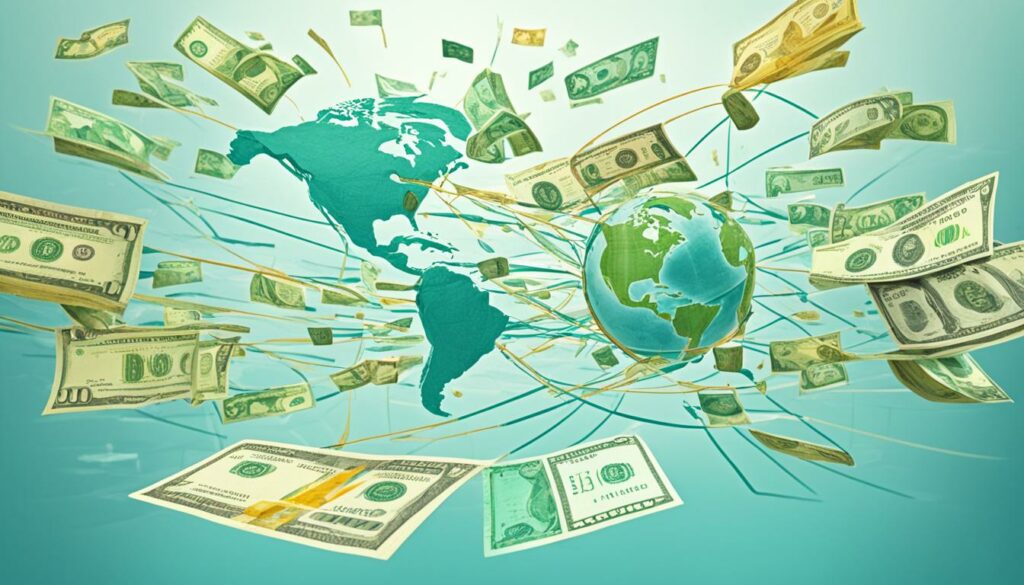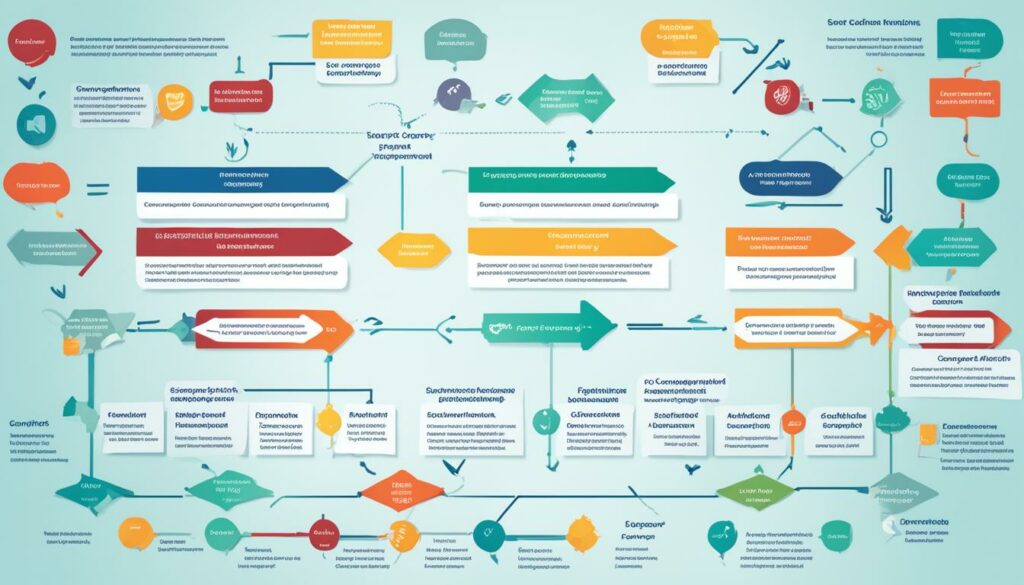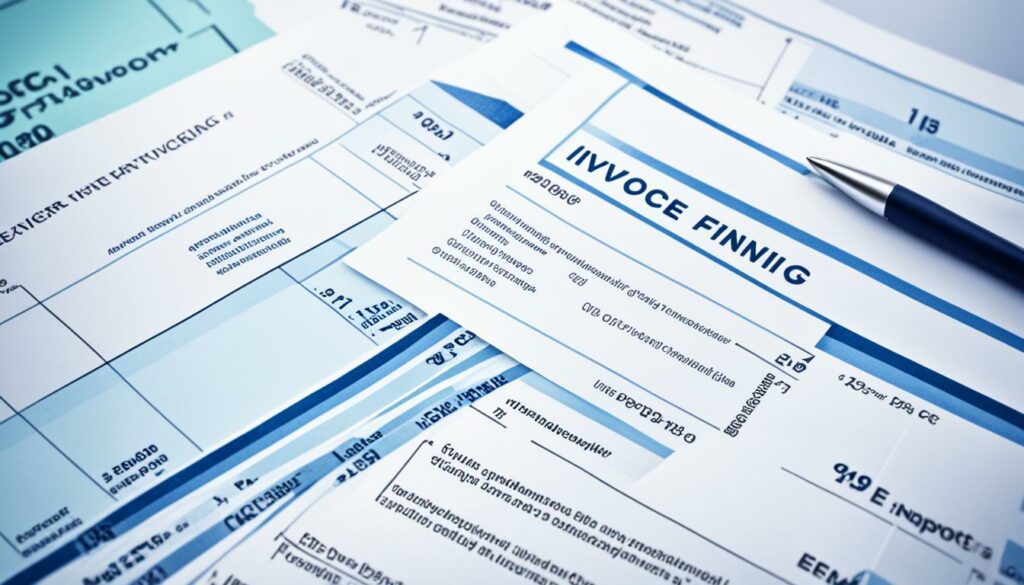Menu

Did you know that some 80% to 90% of world trade relies on trade finance? For US businesses heading into global markets, it’s vital to know about export finance options. This kind of funding offers the needed money for exporting. It can help businesses start moving, even if they’re worried about costs.
Many small to mid-sized enterprises need financial help for exporting smoothly. They can turn to places like commercial banks, federal government programs, the EXIM Bank, SBA, and USDA. These organisations help businesses find the right finance, export their goods, and grow abroad.
Export finance is key for any business in global trade. It gives companies the money they need to sell to customers worldwide. By bridging the gap from making goods to selling them, companies run smoothly without financial stress.
Export finance includes many ways to help exporters financially. This help comes from banks, non-bank financial firms, and newer marketplaces like fintechs. They aim to fund the parts of business linked to exporting, like stock, money owed by customers, and money the business owes to others.
Different types of export finance and trade solutions exist. For example, some involve payments through banks (LCs) or just getting paid once goods are received (collections). Others help through the whole process, from the very start to selling goods. This might include help with buying stock, financing for distributors, and support for goods’ value before shipping.
Export finance is very important for businesses in the global market. It lets exporters deal with risks and meet orders on time. Having these options makes businesses more reliable and attractive to banks for ongoing financial support.
Government-backed finance programs add even more help. These include loans and guarantees. They aim to level the playing field for exporters. Knowing how export finance works can make a big difference in succeeding in global trade.
It’s key for traders to know export finance. They help boost money matters for overseas deals. Each type fits a different step of the export journey.
Pre-shipment finance is a big help. It lets sellers buy materials early. They can prepare products for exporting. This money boost ensures no delays from a tight budget.
Post-shipment finance is also crucial. It aids after products are sent but before payment’s in. This wait usually lasts 3 to 6 months. It’s vital for keeping business running well.
For quicker payments, try bill discounting and invoice factoring. These get you money from invoices sooner. Besides that, LC discounting helps by offering credit security for loans.
Government help is another bonus. It makes goods cheaper abroad. An example is how Indian banks support export finance. They’re directed to do so by the Reserve Bank of India.
Commercial export loans are a banking option. They cover many costs in global markets. These loans are vital for big orders or when cash flow needs a boost for global growth.
Factoring is a favourite for exporters. It turns invoices into quick cash. This way, businesses can grab bigger chances without waiting on payments.
| Type of Export Finance | Purpose | Time Frame |
|---|---|---|
| Pre-shipment Finance | Buying raw materials, processing goods | Before shipment |
| Post-shipment Finance | Providing working capital until payment received | 3 to 6 months |
| Bill Discounting/Invoice Factoring | Faster liquidation of invoices | Immediate |
| Letter of Credit Discounting | Loan against letter of credit | Based on payment terms |
| Government Subsidies | Reduce prices for importers | Ongoing |
Using a mix of export finances can boost your business. It helps take on global trade with strength and sureness.

Exporters need to build strong ties with banks for international trade funding. The government offers export finance programs which banks support well. This mix can help exporters use funds effectively.
Working closely with a bank skilled in global trade finances can be beneficial. They often offer credit lines to back up export deals. The bank may also increase your credit limit or give special export funds. The goal is to build a lasting relationship based on more than just one deal.
Banks’ international sections offer key services for safe trading across borders. This includes letters of credit that ensure exporters get paid correctly. They also help with documentary collections for smooth payment exchanges.
Trade financing involves services like currency exchanges and trade guarantees. Banks help manage currency risks with smart strategies. Their wide range of services highlights how important they are in global trade success.
Many U.S. businesses want to grow globally. Government programs for export financing are key. The Export-Import Bank of the United States (EXIM Bank), the U.S. Small Business Administration (SBA), and the U.S. Department of Agriculture (USDA) help businesses worldwide. They offer financial help for international competition.
The EXIM Bank aids U.S. exports with financial tools. These include export credit insurance, working capital guarantees, and loan guarantees. This helps exporters manage risks and get funding more easily. It’s especially useful for big industries needing a lot of money, like infrastructure and telecommunications.
The SBA export finance programs help smaller companies enter global markets. They offer Export Working Capital and Export Express loans. These loans have good terms and come with advice for trading internationally.
The USDA export finance programs particularly aid the agricultural sector. They’re dedicated to exporters of U.S. agricultural goods. The Commodity Credit Corporation (CCC) Export Credit Guarantee Program is part of this. It ensures the global competitiveness of U.S. agricultural products. The USDA’s efforts help with business growth, working capital, and large projects in agriculture.
The table below compares the key agencies’ financial help:
| Agency | Primary Focus | Key Financial Products | Target Industries |
|---|---|---|---|
| EXIM Bank | Export Credit | Export credit insurance, Working capital guarantees, Loan guarantees | Infrastructure, Telecommunications, Natural resources |
| SBA | Small & Mid-sized Enterprises | Export Working Capital loans, Export Express loans | Various industries |
| USDA | Agriculture | Commodity Credit Corporation Export Credit Guarantee Program | Agricultural sector |
Government programs for export financing are crucial. They reduce financial risks and provide the capital needed for success worldwide. By using resources from these agencies, businesses can meet the financial demands of global trade. This helps them grow and stay competitive.
Finding the right trade finance helps US exporters in international markets. Trade finance is key, with 80% of global trade needing finance.

US exporters can pick from different payment methods for global trade. Each option suits various risk levels and business goals:
Managing risks well is vital for safe and smooth global trade transactions. There are tools and strategies to reduce various risks:
Using these finance solutions and risk management strategies helps US exporters. It makes their operations smoother and increases their global growth with confidence.
Ensuring safe export deals is crucial for business growth. Export credit facilities offer security in global trade. They allow exporters to use safe payment methods like letters of credit and documentary collections.
Letters of credit are key in world trade for their safety net. They offer a buyer’s bank’s promise to pay the seller. This guarantees the seller their money, reducing the risk of non-payment. With ECI covering up to 95 percent of risks, letters of credit are vital for safe trade.
Documentary collections, where banks pass on payment documents between the buyer and seller, build trust. The exporter sends documents to their bank, which forwards them to the buyer’s bank. Payment is then arranged. Although less secure than letters of credit, it helps manage cash flow and cuts payment risks.
Export finance choices boost trust and cut risks for exporters. Insuring foreign sales gives peace of mind. It also makes it easier to get good finance deals. These tools are crucial for success in global markets.
“Multi-buyer policies for export credit insurance cost less than 1 percent of insured sales, while single-buyer policies vary in price,” giving exporters affordable options to manage their risks effectively.
Cross-border financing is becoming popular as more companies look to grow globally. It is key in closing the gap between selling goods and getting paid. We need to understand loans against receivables and receivables purchase agreements well because of their growing use.
Loans against receivables are a key part of cross-border financing. They use future payments from foreign buyers to give exporters cash now. With $7 trillion in loans globally, they are vital in modern trade.
These loans help without stopping the cash flow. They lower trade risk but changes in currency rates can affect payback. This makes things a bit more complex.
Receivables purchase agreements are another way of financing. Exporters sell their invoices to third parties at a discount. This helps keep cash flowing and offers flexible terms. It’s great for those needing more freedom to operate.
This option helps reduce market risks. It manages the danger of not being able to convert foreign currencies. This could stop getting paid.

While there are risks, cross-border financing offers big benefits. Tools like loans against receivables and purchase agreements are key for growing and keeping businesses going. Working with financial experts is crucial for the best financing, especially in new markets.
Navigating international trade can be scary without the right financial support. *Commercial export loans* are crucial for selling products and services worldwide. Banks usually give these loans.
For export financing, many programs are available. These include ones from the Export-Import Bank of the United States and the U.S. Department of Agriculture. Commercial banks also help a lot, offering credit lines and funding for export sales.
Banks like to build long-lasting relationships with businesses. This is more important to them than just one-time financing. U.S. banks, especially those with an international focus, understand export business well. They offer special banking services for export needs.
Working capital loans can be a big help. But, it’s the seller’s duty to repay. If a buyer from abroad doesn’t pay, credit insurance can help. For big buyers in stable markets, medium-term loans might be better. Yet, for risky markets, more safeguards are needed.
The U.S. government has programs like Business Development Financing to support exports. Most exporters in the U.S. are small businesses. Programs like the SBA’s Export Working Capital Program and the Ex-Im Bank’s Working Capital Guarantee Program are critical, offering significant help.
The SBA’s Export Express and International Trade Loan Program support business with export ventures. These, along with Ex-Im Bank’s programs, help provide financing so that international buyers can purchase U.S. products.
The USDA’s Export Credit Guarantees and OPIC’s Financing help too. They allow U.S. banks to give credit, which helps American companies succeed globally.
Big companies might prefer short-term loans for large export deals. This is because they have predictable earnings. Smaller companies, however, might need a credit line. This is good for handling sudden monetary needs. It’s also wise for them to consider insuring against payment risks.
Invoice financing is a smart way for businesses to get money from unpaid invoices fast. It’s especially useful for those selling abroad. This process helps exporters stay financially strong. It means they can handle big projects and work more smoothly.
Here’s how it works: you sell your invoice to a third party for a quick cash boost. Normally, you get up to 80% of its value right away. Some companies, like FundThrough, might even give you the full amount upfront after deducting a small fee.

Stenn, for instance, backed by names like HSBC and Citi, offers this service from just 0.7% per invoice. They make sure the money’s in your bank within two days after approving your request. To be eligible, you need to have at least $100,000 worth of outstanding invoices.
Invoice financing has loads of benefits for exporters. Let’s break it down:
Using invoice financing helps exporters in many ways. It boosts their finance options and gives them an edge in the worldwide market.
Supply chain finance (SCF) is key for better cash flow and supply chain efficiency. It helps businesses get the money tied up in their chains. By doing this, operations go smoothly and growth quickens. Bank of America is a top provider in this area, known worldwide for its skills and achievements.
Loan-based SCF, like pre-shipment finance, aids exporters with their cash flow needs. Before sending goods, they get funding for production expenses. This process makes the pre-shipment phase less stressful. Bank of America has well-regarded SCF services known for their wide reach and effectiveness. It was even hailed as the Best Supply Chain Finance Provider in North America for 2024 by Global Finance.
For exporters needing cash to complete orders, pre-shipment finance is essential. It’s especially helpful for small and medium enterprises in new markets. Bank of America, who was recognised as the World’s Best Bank for Supply Chain Finance in 2023, offers strong pre-shipment finance. Their services are available in over 40 markets and ten languages. They help businesses across various sectors manage the gap between production and being paid.
It’s key for U.S. exporters to know about export working capital options. They help businesses keep up and expand their sales worldwide. These choices ensure there’s enough money to make products or offer services before earnings arrive. The U.S. government’s export finance plans, like the SBA’s Export Working Capital Program (EWCP) and the Export-Import Bank, are major aids.

Small companies often need loans or financial help to start selling abroad. Banks provide ongoing credit, backing up sales abroad and expansion. The EWCP, for example, can cover all the supplier’s costs for an export sale. Loans are usually for a year, renewing yearly with a known fee. These funds help deal with more production or big sale orders.
Cross-border financing also includes special packages like structured trade finance. These are made to cut risk and boost the speed of getting cash for the seller. There’s also support for big projects that need a lot of money. This opens up chances to grow in sectors like building and telecoms.
Here’s a table showing the main points about export working capital:
| Feature | Details |
|---|---|
| Loan Amount | Up to $2 million (EWCP), with a 90% SBA guaranty not exceeding $1.5 million |
| Guaranty Fee | $2,250 for a one-year $1 million line of credit at 90% guaranty |
| Premium Discount | 25% discount on EXIM Bank Small Business Export Credit insurance policy for credit insurance |
| Eligible Entities | Manufacturers, wholesalers, export trading companies, and service exporters meeting SBA size standards |
| SBA Fee | 0.25% for loans with a 12-month maturity or less |
In brief, using export working capital options and cross-border financing helps U.S. exporters a great deal. These resources let firms handle their working money needs well, keep up their output levels, and boost their standing in the world market.
Risk mitigation in export finance is key to avoid big financial hits. Export credit risk is a major threat to firms in global deals. To tackle this, exporters often use export credit insurance and government guarantees.
Export credit insurance helps deal with credit risk overseas. It secures payments if a buyer can’t pay due to various risks. This kind of insurance is crucial for the over 300,000 small and medium U.S. exporters. It lets them protect their working capital. This helps them grow their business with less worry about not getting paid.
Government guarantees play a big part in export risk reduction too. The Export-Import Bank of the United States (EXIM Bank) often provides such guarantees. These help U.S. exporters get loans, even in risky markets. By doing so, these guarantees lower the risk for lenders. This makes financial support easier. They also help with production costs, supporting cash flow until payments are made.
Project financing is a complex method that helps exporters take on big projects. These projects need a lot of money, like in building roads or extracting natural resources. It’s key in areas such as infrastructure and telecoms, where getting funding is hard and risks are many. By using this method, exporters can share the project risks with others. This means no one party has to bear all the risk alone.
Building roads, bridges, and public utilities needs big financial help. The same goes for telecom projects, like putting fibre-optic cables across nations. The Export-Import Bank of the United States (EXIM Bank) offers a way out. It provides help that depends on the money the project makes to pay off its debts. With this financial help, big projects in infrastructure and telecoms are possible without too much risk on any single group.
In the natural resources sector, the money at stake is high. Oil and gas, mining, among others, require lots of money upfront. They also need reliable partners to lower the risks. The EXIM Bank and commercial banks give the money needed for these big projects. They also protect everyone by offering extra help in risky situations. This way, these large ventures get the support they need.
Additionally, the U.S. International Development Finance Corporation (DFC) works with the private sector on important projects. It helps in key industries to grow internationally and be more competitive. For U.S. exporters, working with specialists and government programs is vital. It helps them find the best financing for their big export projects.
Export finance is a set of tools and funds for exporters. It helps bridge the gap between making sales and getting paid. It’s for companies selling goods abroad.
Export finance is vital for businesses wanting to sell overseas. It covers costs and risks, especially for smaller firms. It keeps the cash flowing and deals with trade’s uncertainties.
There are many export finance types. These include government-backed loans and insurance against payment risks. Each option meets different needs, like handling big orders or reducing payment worries.
Commercial banks offer services tailored to exporting. They provide credit lines and guarantee payments. They make sure money moves safely in international deals.
Government bodies like the EXIM Bank support exporting. They offer finance and products to help companies sell overseas. This support is key for growing in global markets.
Payment methods in global trade include cash upfront and credit agreements. These manage the risk of not getting paid. They offer different levels of financial safety.
Export credit facilities are secure finance tools for international sales. Banks check and help process the sale’s paperwork. This adds trust to the deal.
Loans and finance based on sales help exporters with cash flow. They use what they’re owed to fund new sales. This improves how quickly they can take on more business.
Commercial export loans support international selling. They help pay for making and marketing overseas goods. This keeps money flowing and supports big export deals.
With invoice financing, exporters can turn what they’re owed into cash. A financer buys the invoices for immediate funds. This speeds up business without waiting for payments.
Supply chain finance helps keep the cash flowing in a production line. It lets businesses pay for inputs after they’ve sold their products. This finance means they can move ahead without waiting.
These options include loans and finance designed for exporters. They cover costs until the goods are sold. They support international sales growth without depleting cash reserves.
Export credit insurance and government guarantees lessen the risk of not getting paid. They make financing safer for banks and more appealing to companies.
Project financing is for big export initiatives, like building projects. It spreads the risk among involved partners. The projects are planned to pay for themselves.